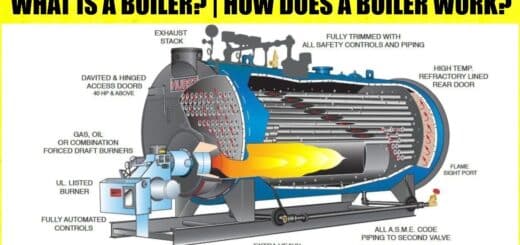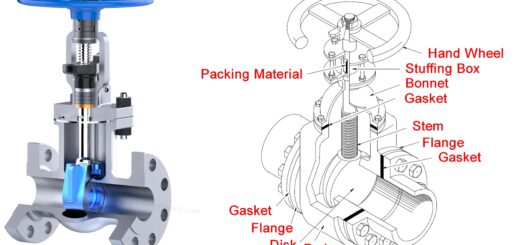What is Pump? Types of Pump, Uses, Working & Application [with Pictures]
![What is Pump? Types of Pump, Uses, Working & Application [with Pictures]](https://engineeringlearn.com/wp-content/uploads/2021/11/Pump-1024x539.jpg)
Definition of Pump
What is Pump? Types of Pump, Uses, Working & Application [with Pictures] :- Pumps can be defined as the devices which are used to pump fluid and they can be submerged in the fluid or placed external to fluid.
Pumps are categorized on the basis of method of displacement such as impulse pumps, positive displacement pumps, gravity pumps, velocity pumps, valve less pumps and steam pumps. Pumps can be differentiated in three basic types such as axial flow pumps, centrifugal pumps and positive displacement pumps. The flow direction of fluid in centrifugal pumps changes by 90 degree to the direction of flow on impeller, but the flow direction is unchanged in case of an axial flow pump.
Different Types of Pump
1. Positive Displacement Pumps: ( Types of Pump )
Fluid in positive displacement pump moves by trapping fluid of fixed amount and then displacing the trapped fluid in discharge pipe. In suction side, expanding cavity is used in some positive displacement pumps and on discharge side decreasing cavity is used. In suction side as the cavity expands liquid flows in pump and when the cavity collapses the liquid flows out. Therefore resulting in a constant volume in every cycle of operation.
These pumps should not be operated with valve of discharge side closed because they do not have shut off head. If they are operated with valve closed in discharge side then the pressure and the flow increases in discharge line resulting in heavy damage of pump, line bursting or both. On discharge side a safety valve or a relief valve is required for this purpose and the relief valve can be external or internal. Only for safety precautions internal valves are used but the external relief valve provide extra safety to the equipment as well as for humans.
Types of Positive Displacement Pumps
Positive displacement pumps are classified on the basis of the mechanism used for fluid flow. The types are:
A) Rotary Type Positive Displacement Pumps
In Rotary type positive displacement pumps fluid is moved with the help of rotating mechanism which results in creating a vacuum which traps and draws in the liquid.
- Advantage : Rotary type positive displacement pumps are efficient due to their high handling capacity of fluids which are highly viscous in nature flowing with a higher rate.
- Disadvantage : One of the major disadvantages of this type of pump is that they need close clearance in between the outer edge and rotating pump which results in slow rotation with steady speed. They can cause erosion if rotated at high speed and this results in more clearance therefore efficiency decreases.
- Example : External or internal gear pump, lobe pump, screw pump, liquid ring pumps or helical twisted roots, sliding vane or flexible vane, shuttle block, flexible impeller, circumferential piston pumps.
B) Reciprocating Positive Displacement Pumps
In Reciprocating positive displacement pumps the movement of fluid is done with the help of one or more oscillating plungers, pistons or diaphragms (membranes), and the valves are used for restricting the motion of fluid in the desired direction. For suction, the pump is required to pull plunger in the outward motion for decreasing the pressure of the chamber. And when the plunger is pushed back then the pressure in chamber increases and the plunger’s inward pressure eventually results in opening of the discharge valve. Thus the fluid is released to the delivery pipe with high velocity.
In general these pumps have one cylinder but many reciprocating positive displacement pumps have duplex or triplex cylinder in rare case quad cylinders or more can be seen. These pumps are powered by air, steam or manually or by belt driven by engine. They were widely used in 19th century. Reciprocating positive displacement pumps are used for special applications in which lesser rate of flow are required against high resistance.
Types of Reciprocating Positive Displacement Pumps
a) Plunger Pumps
In plunger pumps, the fluid is pushed by a reciprocating plunger through one or two valves. These valves are opened and closed by the suction in way back.
b) Radial Piston Pumps
In these Reciprocating positive displacement pumps the pistons are extended in radial direction.
c) Piston Pumps
These Reciprocating positive displacement pumps are quite simple and are used to pump less amount of gel or liquid manually. Example: Hand soap dispenser.
d) Diaphragm Pumps
These pumps are quite similar to the plunger pumps. These pumps are used for pumping toxic and hazardous fluids.
Pumps Which Work on the Principle of Positive Displacement are:
1. Gear Pump
Gear pumps are the simplest pumps among rotary positive displacement pumps. Gear pumps have two meshed gears which are rotated in a casing which is closely fitted. The fluid is trapped by the tooth space and then the fluid is forced around outer periphery. The fluid cannot go back to the meshed part because in the center the teeth mesh is closed. These pumps have wide use in the engine of car for oil pumps.
2. Progressing Cavity Pump
Progressing cavity pump are widely used pumps for pumping difficult materials like sewage contaminated with large particles. Progressing cavity pumps have a helical rotor which is 10 times longer than its width. The shaft of the progressing cavity pump rotates and the rotor forces the fluid up the rubber sleeve. Progressing cavity pumps develop high pressure at low volume.
3. Screw Pump
Screw pumps are quite complicated rotary pump and they use two or three screw with opposing thread: one screw turns counter clockwise and the other screw turns clockwise. On the parallel shafts the screws are mounted. The shaft has a gear with mesh therefore shafts turn together whereas everything else stays in place.
4. Peristaltic Pumps
These pumps are positive displacement pumps, they contain fluid in tube (flexible tube) fitted in circular pump casing. A number of shoes, wipers and rollers are attached to the rotor which compresses the tube. When the rotor turns then the tube part which is under compression closes. This leads to forcing of the fluid by the tube. When the tube is open it draws fluid in pump and this process is known as peristalsis.
5. Root Type Pumps
These pumps are named on Root brothers who invented the Root type pumps. Root type pump displace liquid by trapping in between two helical rotors which are fitted with each other at 90 degrees. They provide continuous flow with equal volume without vortex. Root type pumps work at low pulsating rate and provide smooth performance which is required by some applications.
Applications in which root type pumps are used:
- Industrial air compressors of high capacity.
- Internal combustion engines.
- Civil defense siren.
6. Rope Pumps
Rope pumps are made up of simple materials like a wheel, a rope or a PVC pipe.
7. Plunger Pumps
These pumps are reciprocating positive displacement pumps. They consist of a cylinder with the reciprocating plunger. The discharge and suction valves are mounted over the cylinder head.
8. Compressed Air Powered Double Diaphragm Pumps
Compressed air powered double diaphragm pumps run on compressed air. By design these pumps are safe to use. They are less expensive and can be used for performing wide range of duties from pumping hydrochloric acid from secure storage to pumping water out of bounds.
9. Triplex Style Plunger Pumps
These pumps use three plungers for reducing the pulsation of the single reciprocating plunger pumps. When these pumps have number of plungers working together then the flow is increased. Also the flow is smooth without pulsation damper.
Gas and oil drilling industry uses triplex pumps.
2. Impulse Pumps: ( Types of Pump )
Impulse pumps generally uses gas pressure which is usually air. In few impulse pumps, the liquid trap the gases which are released in pump and accumulated somewhere in pump. This in turn results in creating pressure which pushes the liquid upwards.
The pressure in impulse pumps is also created by hydrocarbon’s burning. And pumps which have this type of combustion driver can transmit impulse directly. For direct transmission pumps are made up of silicone rubber or elastomer completely.
Types of Impulse Pumps
Hydraulic Ram Pumps : These pumps are powered by hydropower. In these pumps the low head water supply kinetic energy is temporarily stored in air bubble hydraulic accumulator which is further used for driving water at higher head.
Pulser Pumps : These pumps are powered by natural resources, with only kinetic energy.
Airlift Pumps : The airlift pumps are run on air which is inserted in the pipe which results in pushing up water as the bubble moves upward.
3. Velocity Pumps: ( Types of Pump )
In velocity pumps, kinetic energy is added in the fluid by increasing the velocity of flow. Increased energy is then converted for gaining potential energy or pressure at the time of reduced velocity. The conversion of Kinetic energy into Potential energy is explained by Bernoulli’s principle or 1st law of thermodynamics.
Velocity pumps have the following features:
- Continuous energy
- Conversion of added energy into increasing the velocity.
- Conversion of increased kinetic energy into increased pressure head.
The common difference in between the positive displacement pumps and dynamic pumps is their operation at closed valve conditions. Fluids in positive displacement pumps are displaced physically therefore continuous pressure build up if the downstream valve of the positive displacement pumps are closed and results in pump failure, pipeline failure or mechanical failure. But in dynamic pumps when the valves are in closed condition can be operated safely for short period of time.
4. Radial Flow Pumps: ( Types of Pump )
Radial flow pumps are also known as centrifugal pumps. The fluid in radial flow pumps enter along centre or axis and then fluid is accelerated with the help of impeller and exits radially. Vortex pump is an example of radial flow pump. Usually radial flow pumps are operated at low rate of flow and high pressure in comparison to axial or mixed flow pump.
5. Axial Flow Pumps: ( Types of Pump )
Axial flow pumps are also known as all fluid pumps. Fluid is pushed inward or outward for moving the fluid axially. Axial flow pumps are operated at high rate of flow and low pressures as compared to the centrifugal pumps.
Mixed flow pumps operation functions are in between axial flow pumps and radial flow pumps. In this case fluid will experience both lift and radial acceleration and the fluid exit impeller in between 0 degree to 90 degree from the axial direction. Therefore the operation of mixed flow pumps are at higher pressure in comparison with axial flow pump but mixed flow pumps delivers discharge higher than the radial flow pumps.
6. Regenerative Turbine Pumps: ( Types of Pump )
Regenerative turbine pumps are also known as friction, drag, peripheral, liquid ring, traction, side channel, vortex or turbulence pumps. These pumps are from the class of roto-dynamic pumps which are operated at high head pressure (58 psi to 290 psi). Regenerative turbine pumps have impeller with number of paddles or vanes which spins in cavity. These pumps cannot be vapour locked and usually applied to hot, cryogenic and volatile fluid transport. Regenerative turbine pumps have low efficiency and they have decreased pressure and power consumption with the flow. The pumping direction in regenerative turbine pumps is reversed by reversing the spin direction.
7. Eductor Jet Pumps: ( Types of Pump )
Eductor jet pumps use jet generally of steam for creating low pressure and this pressure sucks the fluid and then propel in high pressure region.
8. Gravity Pumps: ( Types of Pump )
These pumps consists Heron’s fountain and Syphon. Sometime hydraulic ram is also called gravity pump. The water in gravity pumps are lifted with the help of gravitational force.
9. Steam Pumps: ( Types of Pump )
Stem pumps include pumps which are powered by steam engine and piston-less pumps like Pulsometer steam pump or Thomas Savery.
10. Valveless Pumps: ( Types of Pump )
Valve-less pumps have various applications in transporting of fluid in engineering as well as biomedical system. In these pumps, for regulating the direction of flow no valves are present. Valve-less impedance pumps are used in microfluidics for handling of sensitive bio fluids. Valve-less pumps are also used in ink jet printers which operates on the principle of piezoelectric transducer.













